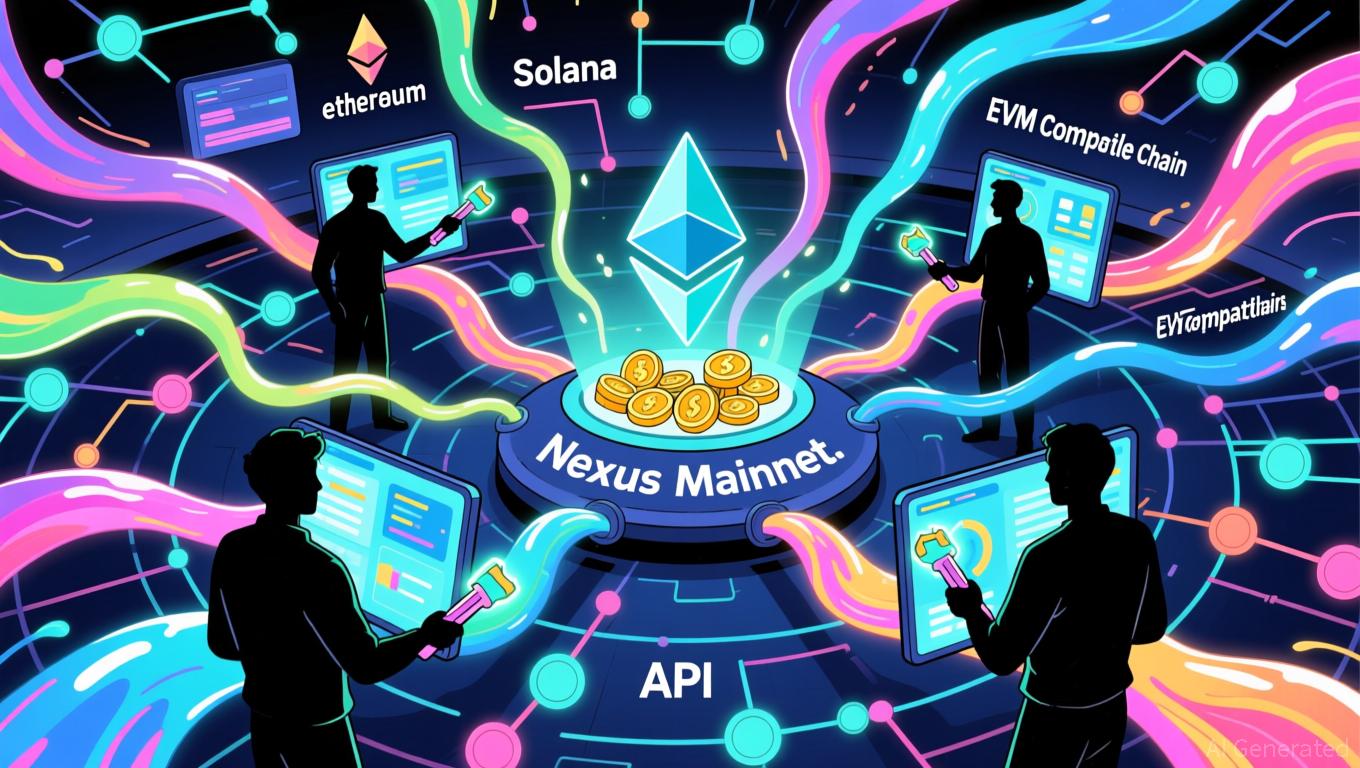Avail's Intent-Driven Nexus Addresses the Issue of Fragmented Liquidity Across Chains
- Avail launches Nexus Mainnet, a cross-chain solution unifying liquidity across Ethereum , Solana , and EVM networks. - The intent-solver model enables seamless asset transfers without technical complexities, streamlining user experiences. - Developers gain modular tools for multichain integration, reducing costs as cross-chain liquidity demand grows. - Nexus abstracts execution layers, offering unified balances and execution while addressing fragmentation challenges. - With $50B+ in cross-chain activity
Avail Unveils Nexus Mainnet: A New Era for Cross-Chain Blockchain Connectivity
Avail has officially introduced Nexus Mainnet, a groundbreaking cross-chain platform crafted to unify liquidity and enhance user experiences across leading blockchain networks such as Ethereum, Solana, and other EVM-compatible chains. This innovative system, described as a "coordinated operational universe," is designed to do away with fragmented bridging solutions and scattered liquidity by enabling effortless asset transfers and transaction execution across multiple blockchains. The launch represents a significant advancement in blockchain infrastructure, establishing Avail as a major force in tackling persistent interoperability issues.

How Nexus Works: Intent-Solver Model
Nexus introduces a novel intent-solver framework, allowing users to simply state their desired outcomes—such as moving assets or making trades—without needing to navigate the technical intricacies of cross-chain routing. The network’s solvers automatically determine the best liquidity sources and execution routes, delivering reliable results while reducing operational complexity. For developers, Avail provides SDKs, APIs, and modular components that make it easy to embed multichain capabilities into their applications, significantly lowering the barriers and costs associated with building cross-chain solutions.
Application-Layer Abstraction: A New Approach
Unlike conventional bridging or shared-sequencer models, Avail’s strategy centers on abstracting the application layer. Rather than requiring changes at the protocol level, Nexus acts as a coordination layer that synchronizes user interactions, offering a unified balance overview and seamless execution across different blockchains. This approach reflects the growing demand for user-friendly blockchain experiences, where individuals engage directly with applications instead of dealing with the complexities of underlying chain infrastructure.
Industry Momentum and Unified Liquidity
The launch of Nexus coincides with a broader industry movement toward cross-chain liquidity solutions. For example, USDT0—a cross-chain stablecoin platform—recently surpassed $50 billion in total value transferred across 15 blockchains, underscoring the appetite for integrated liquidity. Avail’s Nexus seeks to capitalize on this trend by addressing issues like fragmented user journeys and inefficient liquidity routing.
Benefits for Users and Developers
- For users: Nexus promises quicker, more transparent transactions with lower gas fees and reduced bridging costs.
- For developers: The platform offers real-time collateral pooling and intent-driven trading, unlocking new possibilities such as cross-chain DeFi strategies and SocialFi integrations.
Early adopters include projects like Lens Protocol and TRON, both of which are utilizing Nexus to broaden their capabilities across various ecosystems.
Strategic Impact and Future Outlook
The implications of Nexus extend beyond technical enhancements. By abstracting cross-chain execution, the platform could redefine market structures, positioning liquidity routing and solver networks as foundational infrastructure. This evolution may accelerate the adoption of intent-based models, where user objectives dictate execution rather than manual route selection.
Challenges and Roadmap
Despite its promise, Avail faces hurdles such as competition from established bridging solutions and the necessity of maintaining secure solver networks. However, the company’s emphasis on verifiable data availability (leveraging Avail DA) and modular design equips it to tackle scalability and security challenges. With Nexus Mainnet now operational, Avail’s next steps include expanding support for additional blockchains and forging new ecosystem partnerships, with Solana integration planned for upcoming releases according to the company’s roadmap.
Disclaimer: The content of this article solely reflects the author's opinion and does not represent the platform in any capacity. This article is not intended to serve as a reference for making investment decisions.
You may also like
Bitcoin News Update: Major Institutions Wager on Bitcoin’s Long-Term Potential as Expectations of Fed Rate Cuts Drive Surge to $93K
- Bitcoin surged to $93,000 on Nov 25, 2025, driven by 85% odds of a Fed 25-basis-point rate cut in December. - XRP rose 11% and Ethereum hit $2,900 as improved liquidity and macro sentiment fueled crypto optimism ahead of the Fed's Dec 10 meeting. - Institutional demand grew with Texas and Harvard investing in Bitcoin ETFs, while Abu Dhabi tripled its ETF holdings to $517.6 million. - Risks persist: ETF outflows, leveraged fund liquidations, and regulatory uncertainties offset gains, with derivatives posi

Ethereum Updates Today: MegaETH's $1 Billion Funding Failure Highlights Blockchain Scaling Challenges
- MegaETH canceled its $1B fundraising after technical failures caused unintended deposits and operational chaos during the pre-deposit phase. - KYC system errors and premature execution of a multisig transaction led to $500M in deposits, forcing the team to freeze the raise and abandon expansion plans. - Critics highlighted preventable engineering flaws, with 259 duplicate addresses raising concerns about bot activity and unfair allocation practices. - Despite backing from Vitalik Buterin and Joe Lubin, t

Ethereum News Update: Canton’s Privacy-Centric Approach Attracts Institutions Away from Public Blockchains
- Canton Network's tokenomics strategy prioritizes institutional adoption by avoiding ICOs and focusing on privacy and interoperability. - Its "need-to-know" privacy model enables regulated access to transaction data, aligning with KYC/AML frameworks while maintaining confidentiality. - Institutional backing, including $135M funding and Goldman Sachs integration, highlights Canton's appeal for enterprise blockchain solutions. - Canton's RWA TVL ($96 per $1 cap) outperforms Ethereum ($0.03), emphasizing its
Hyperliquid News Today: SEC Approval Ignites Triple Crypto Rally: ETFs, Cross-Chain Bridges, and Retail Frenzy
- Institutional investors are accelerating crypto adoption via Avalanche-based ETFs, with Bitwise’s 0.34% fee BAVA ETF offering staking yields and cost advantages over competitors. - Avail’s Nexus Mainnet bridges Ethereum and Solana ecosystems, streamlining cross-chain liquidity and reducing fragmentation through a unified network. - Retail hype drives Apeing’s presale as a potential 100x opportunity, leveraging meme coin dynamics and FOMO to attract speculative traders. - SEC’s evolving regulations and in